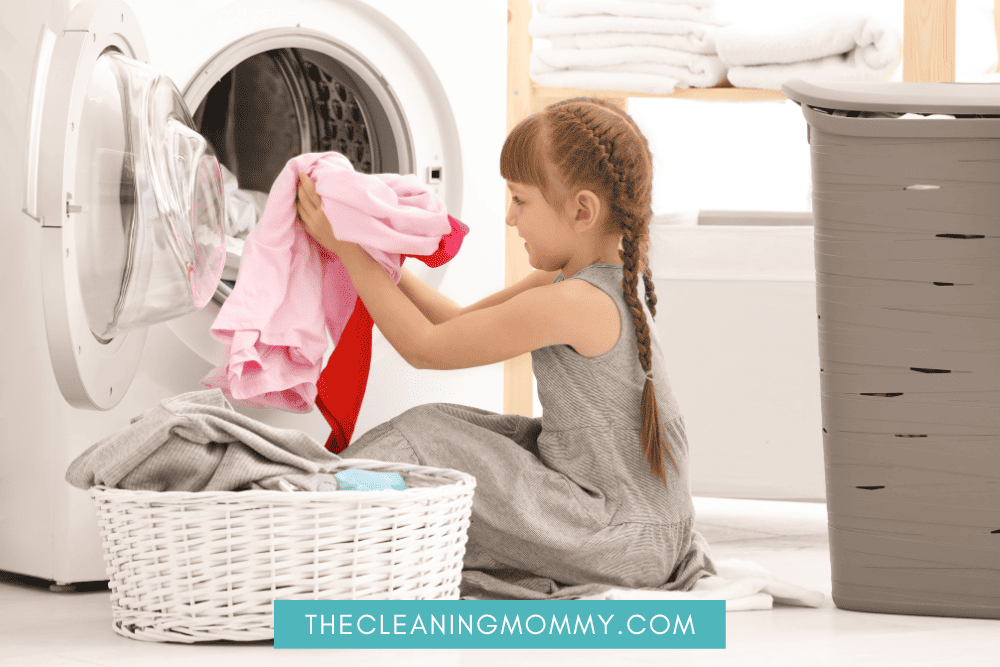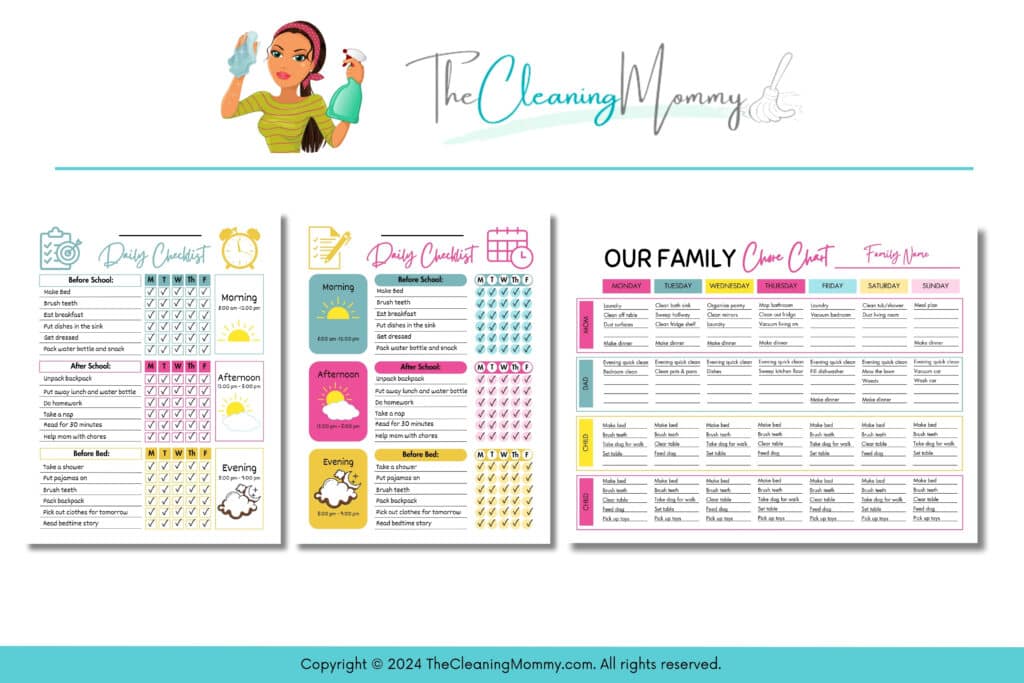Creating a family chore chart can be the key to harmony and productivity at home. Being a stay at home mom doesn’t mean that you have to take care of the entire house on your own, while raising littles! Between making meals, doing the laundry, cleaning, and running errands, keeping up with daily chores can get overwhelming. The good news is that YOU don’t have to and should not do everything alone.
The best way to keep the household running smoothly is to encourage everyone in the family to pitch in. In this blog post, I will give you some valuable tips on how to create a family chore chart that will help to keep your home organized and efficient.
With everyone leading busy lives, it’s easy for chores to pile up or for one person to inadvertently become the family pack mule – YOU. It’s important to your mental health that you don’t take on all of the household tasks when there are other family members in your house!
A well-planned chore chart not only helps divvy up tasks fairly, but also fosters a sense of responsibility and teamwork.
Guess what?
Your kids actually need chores! And not just because it’ll make your life a whole lot easier (although it definitely will). Chores are actually super beneficial for your kiddos, both now and in the long run.
What may start as a weekly routine to tidy up the living room or clear the kitchen floor can blossom into a child’s understanding of time management, the principles of earning money, and the satisfaction of a job well done.
Key Takeaways:
- A family chore chart helps the entire family out & stops mom from being overloaded!
- Chores are good for kids, they build self esteem and responsbility.
- When every family member gets involved, chores get done faster.
- A family chore chart helps the household to run smoother!

Understanding the Purpose of a Family Chore Chart
Creating a family chore chart is about instilling a sense of responsibility and teamwork. It helps organize and distribute household tasks fairly among all family members, ensuring that everyone understands their own roles and contributions.
By using a chore chart, you can:
- Track progress: See at a glance who’s responsible for what and if they did their assigned tasks.
- Foster accountability: Everyone knows what they need to do, and checking off completed household tasks can be really satisfying.
- Encourage independence: Kids, in particular, learn to take the initiative on their chores without constant reminders.
- Teach life skills: You are teaching your kids to take care of themselves and be self sufficient and independent (this is something all kids need)
- Mom gets a break!
Remember, your goal isn’t perfection, but rather to create a simple way where each person contributes to the household in a manageable way. Your family chore chart can be simple or detailed, but it should be clear and easy to follow.
Use symbols, colors, or stickers to make it friendly and fun, especially if you have younger children.
Here’s a simple example of what a weekly chore chart might look like:

This chart keeps you and your family on the same page. Everyone knows what their household chores are each day. Please remember, the littles will have to be reminded of this until it becomes a routine for them, and that will take time, but it will be worth it in the end, so please don’t give up!
This chart keeps you and your family on the same page. Everyone knows what to expect each day, and you can adjust tasks based on schedules and individual capabilities. So If little Susie has soccer after school on Tuesdays and Thursdays, she won’t be able to do a big task, but a small task would work, like spending 15 minutes cleaning her home.
Involving the Whole Family
You might be thinking, “Age 3? Really?” YES, start them young. Tiny tots are bundles of energy, always looking to be a part of the action. They may drop more crumbs while helping to sweep the floor, but they’ll have a blast while doing that!
When my son was 3, he loved to help push my laundry cart to the laundry room and help put clothes into the washing machine. Then he would help push it back to the master bedroom where we put away laundry together. I would have him match socks and fold dish towels, while I did the rest. He was a happy little boy!
Little kids want to be included!
Getting them involved early fosters a spirit of cooperation and a healthy work ethic, setting a foundation that lasts a lifetime.
Picture this: your preschooler setting the table. It’s not just about placing forks and spoons; they’re taking on more responsibillity and doing chores on their own (with a little help from mom).
As they get older, they will be able to help sort laundry, sweep the floor and prep simple meals. So by the time they become teenagers, they are able to make full meals and do their own laundry! Each step is a rung on the ladder to self reliance!
Ready to tackle your kids’ chores?
Here’s a step-by-step guide to get you started on creating the best chore chart for your family:

#1 Set Your Expectations From The Beginning
Consider your kids’ ages and abilities and make a list of chores you want them to do. These need to be age appropriate chores, and you want to think about what chores you want them to do on a daily and a weekly basis. These should be things that you think they can handle with a bit of guidance from you.
Don’t worry, we’re not expecting them to become household superheroes right away. We’ll start off with some easy tasks.
It might look something like this:
- Daily: Things like making their bed, brushing their teeth, putting dirty clothes in the hamper, picking up toys at the end of the day.
- Weekly: A weekly chore might be them helping to pull all the sheets off their bed so they can be washed, or helping to dust, or watering the plants around the house.
#2 Use Age Appropriate Chores
It’s really important that you start your child off with chores that are suitable for their age. Asking your toddler to empty a dishwasher is asking for trouble (bye bye favorite dishes).
So make sure to use chores that are appripriate for their age, see the example below.
- Toddlers (Ages 2-3)
- Pick up toys
- Wipe up spills
- Preschoolers (Ages 4-5)
- Set table
- Put dirty clothes in hamper
- Kids (Ages 6-9)
- Feed pets
- Rake leaves (with supervision)
- Tweens (Ages 10-13)
- Vacuum rooms
- Prepare simple meals
- Teens (Ages 14+)
- Mow lawn
- Wash the car
- Babysit siblings
#3 Start Small
You don’t want to start by giving your child 5 tasks to accomplish in one day, if you do, they will fail and you will give up on the whole project!
Instead, select a few tasks from your list that are manageable for your child.
Start small and gradually add more as they master each one. Building habits step-by-step increases the chances of success.
So today, they will make their bed and do their teeth, have them do that for at least 5 days, and then add putting dirty clothes in their hamper! Once they have that down, you can add in setting the table for breakfast.

#4 Be Patient
Please remember that your child is never going to do a chore the same way you do it, and that’s okay! This is something that is going to pay off in years to come, when you have strong, independant teenagers that can look after themselves!
Be patient and remind them how well they are doing, encouragement is the key to getting kids to do chores.
#5 Show Them How
For the first few weeks, you will need to show them how to do each chore, remember this is completely new to them, Something that seems really easy to you, is a big deal for your littles.
Sure, it’s tempting to handle all the chores on your own and leave the kids out of it. But when you involve them, it makes them feel special, valuable, and teaches them to be helpful.
I know it takes a lot more effort to include them right now, but you need to look at the big picture. Do you really want to have your kids bringing home their laundry every weekend from college because they don’t know how to do it themselves lol!
#6 Encourage & Praise Them
If you want to keep your kids motivated in doing their chores, encourage and praise them. Kids want to feel helpful, they want to feel like they are helping mom out. So continue to praise them and show them what a good job they are doing, use words like “Look at what a good job you did making your bed, you’re such a big boy, or “thank you so much for helping mommy empty the dishwasher, with your help I was able to do it much faster than if it was just me!”
Let them know how much you love hanging out with them, and how much fun you have together. .
Always remember, your child wants to hang out with you all day long, so if they feel like they actually helped you – that’s a big day for them!

#7 Don’t Critize Them
As I mentioned earlier, your child is never going to do any chore as well as you! They’re 5 and you’re you know – not 5! So, if they are setting the table the wrong way, quietly offer assistance, try something like this “Ooh that looks great, let me show you an even easier way to set the table, here try this way”
But at the end of the day, if setting the table takes them 15 minutes instead of 5 – they don’t care!
They’re chuffed to be helping out!
#8 Assigning Frequent Tasks
Now that you have your list of tasks for the littles to do, it’s time to turn it into a schedule. Look at your calendar and assign specific cleaning tasks to certain days of the week. Be sure to consider any other commitments or important events you have coming up. For example, if you know you have a busy day on Tuesdays, assign lighter cleaning tasks to that day. Or if you have sports events at the weekend, don’t decide to make that a major laundry day!
Having a specific cleaning schedule for each day of the week can help you stay on track and feel less overwhelmed by cleaning.
Establish a schedule for when chores need to be done. Find times throughout your day, such as before school or before bedtime, to fit in tasks.
For example in our house, the kids know to get chores done before asking for any screen time! My daughter empties the dishwasher every morning before school, and my son vacuums and mops every Saturday!
#9 Use a Visual Chore Chart
Once you’ve got your chore chart designed, it’s crucial to place it where everyone can see it and stick to a routine to keep it updated.
Choose a high-traffic area in your home for the chore chart, like the kitchen or hallway, where it’s easily seen by everyone. You might use a magnetic whiteboard on the fridge or a cork board in the hallway. Make sure it’s at eye-level for both adults and kids. You could use color-coding for each family member’s tasks or fun magnets to highlight certain chores.
I recommend using picture chore charts with very young children and then place them in their rooms and bathrooms so they know exactly what they are supposed to do! You can print them out and laminate them so they don’t get torn or crumpled!

#10 Chart Maintenance Routines
To keep your family on track, establish a daily or weekly time for reviewing the chore chart together. Use this time to check off completed chores and prepare for the next day or week. Consistency is key; so pick a routine that works for you, perhaps after breakfast or every evening before bed.
Update the family chore chart as needed, maybe with stickers for a job well done or making note of any changes in chores for the upcoming days. Say for example, you have guests coming for the weekend, it’s likely you will have to move cleaning tasks that are normally done on a Saturday to Thursday or Friday!
#11 Monitoring Progress
Keeping an eye on the chore chart helps maintain momentum and ensures everyone is contributing.
Use a Checkmark System: Place a checkmark or sticker next to each task as it’s completed. This way your child gets to see that they completed their chores chart and receives praise for it
If they accumulate enough stickers, then maybe they can cash them in for a special treat, like some extra cuddle time with mom and dad or an ice cream, or a movie night.
There you have it! Follow these simple steps to create a family chore chart that works for the whole family. It will take a little bit of extra time in the beginning to get a routine going, but once that routine sets in, things will get a little easier.
Creating a cleaning schedule that works for you is all about figuring out your cleaning priorities and fitting them into your schedule. Remember to be flexible and not get too bogged down by the specifics of your schedule. The goal is to have a cleaner and more organized space that allows you to spend more time with your family and doing the things you love.
Remember, teaching your kids valuable skills and independence is a rewarding journey. Stay positive and enjoy the benefits that come with instilling good habits in your children.
If you want to purchase the family chore chart shown above, you can purchase it here
Happy cleaning! .
Other Cleaning articles you may like:
- How to speed clean your home
- 8 Chores your teen should be doing at home right now
- The best morning routine to get stuff done
- How to declutter when you have zero to no time
- 7 Things I do every day to keep a clean home
- The best laundry hacks to help you get laundry done faster!

Grainne Foley
Grainne Foley is a wife and mother of 2 great kids. During her 5 years of full time RV travel, Grainne learned to become very efficient at household chores, in order to make time for family adventures. Now, back in a house, she has continued to create tools and techniques to help others lighten the load of household organization and cleaning.



Leave a Reply